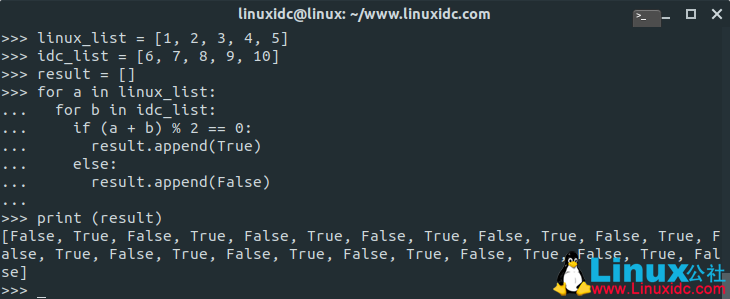>>> os = ["linux", "ubuntu", "debian", "centos"]
>>> site = ["linuxidc", "uc", "dell", "python"]
>>> mingchen = []
>>> for a in os:
... for b in site:
... if b.startswith(a[0]):
... mingchen.append(a + " " + b)
...
>>> print (mingchen)

示例:带有if-else子句的列表推导式
下面的示例将显示列表推导式中if和else语句的用法。
>>> linux_list = [1, 2, 3, 4, 5]
>>> idc_list = [6, 7, 8, 9, 10]
>>> result = [True if (a + b) % 2 == 0 else False for a in linux_list for b in idc_list]
>>> print (result)

在遍历两个列表时,上面的列表领略查抄这对元素的总和是否为偶数。 运行上面的代码将为您显示[False, True, False, True, False, True, False, True, False, True, False, True, False, True, False, True, False, True, False, True, False, True, False, True, False]作为输出。 不利用列表推导式,代码如下所示:
>>> linux_list = [1, 2, 3, 4, 5]
>>> idc_list = [6, 7, 8, 9, 10]
>>> result = []
>>> for a in linux_list:
... for b in idc_list:
... if (a + b) % 2 == 0:
... result.append(True)
... else:
... result.append(False)
...
>>> print (result)

总结
列表推导式提供了一种编写简捷轮回语句的好要领。可是,假如利用多个轮回和条件语句,它们大概很快变得巨大和难以领略。不外编写显式、可读、易于调试的代码是一个好习惯,而不是太过利用缩写。
